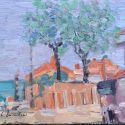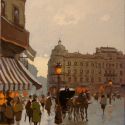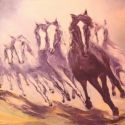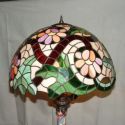Monarchy, term of Greek origin (monos archein), meaning one leader, is a form of autocratic governance by a single leader of a state - the monarch. The term has changed its significance, in time becoming the equivalent of dictatorship, despotism, and absolutism or autocracy. The modern sense of the word monarchy refers to a rather traditional system of leadership based on the principle of heredity. In most cases, the monarch inherits the title and is named leader of the state for as long as he lives. However there are some exceptions to this rule, mainly: - Andorra Dynasty - in France, where members are voted by people every five years- Yang di Pertuan Agong title that designates the supreme leader of Malaysia, where the monarch governs for five years as well. Though the latter disobey a strict rule of the monarchic system, this kind of governance still belongs to monarchy because of the notoriety noblemen titles born by those leaders. Historically, monarchs have been more or less absolute leaders. They usually represented a vast system that functioned on pre established rules and customs regarding succession, duty and power. The majority of monarchs were brought up by royal families and trained for their future duties ever since little children. After the death or abdication of a monarch, the leadership of the state would usually be taken over by the eldest member of the family. Types of successionMonarchic successions differ from one country to another. Traditionally, hereditary succession among members of the same family is the most encountered one. Common hereditary succession is based on certain criteria related to birth and age, though sometimes merit plays an important role as well. However, the most common hereditary system in feudal Europe is based on the appurtenance of the first born to the family, where the master was succeeded by his elder child, and in case the latter was not a boy, by hisdaughters or the sons of his daughters. Whereas for the tanistric succession, the monarch was elected by vote, thus his merits and abilities were highly important. The quassalic succession allowed men succeed the throne proprietarily if they belonged to royal families and secondarily if they descended from femalemembers of royal families. The majority of feudal regions were characterized by women (sisters or daughters to the monarch) being allowed to the succession to the throne only if there were no male successors. However it was the husband of the female successor that became the real leader and most often gained the title of jure uxoris (by which he becameentitled to all of his wife's rights).Great Britain and Spain continue in promoting this legislative model of succession, under the following principle: the right of the first born, indifferent if it is a male or female (cognatic succession). Given the increasing life hope among gentry (due to them not taking part to dangerous battles and the improvement of life conditions at the level of the wealthy),the elder boy could reach maturity before the death of his father, thus the principle of the first born became more used in the detriment of other principles such as: proximity, tanistric system or voting system. Later on, when land was strictly divided between noblemen and tended to remain as established, the Agnatic succession of the first born (correspondent to the salic succession) became more utilized: the eldest of the monarch's sons would succeed the throne, in case the monarch had no sons the throne was taken by the closest male relative.In some countries however, the female succession was not entirely abandoned, thus if the monarch had no sons, the throne would be taken by the eldest daughter and her successors (this principle was the rule that allowed Elizabeth II become a queen). In 1980 Sweden became the first European monarchy that gave up for goof the inclement towards male succession, declaring the equal rights of the first born to succeed the throne, so as the eldest of the monarch's children, whether it was a girl or a boy, could now have access to the throne. Other kingdoms (Norway, Belgium, Holland), followed the same example. In some monarchies such as Saudi Arabia, succession to the throne was usually granted to the elder brother of the monarch, and only after him to the monarch's children. In other monarchic systems, such as Jordan, the monarch would choose the one to follow him tothe throne, not necessarily his eldest son. Typology: We can identify the following stages in the evolution of monarchy:- Absolute monarchy, the oldest form of monarchy, is characterized by the discretionary power of the monarch in the state. This type of monarchy, specific until the French Revolution, existed until recently, mentioning that at the early last century there still existed two other absolute monarchies: The Russian Empire and the Ottoman Empire - Limited (constitutional) monarchy is defined by the limitation of the king's power by means of fundamental laws in a state; the attributions of the gathering are however reduced and the monarch still has a significant role. - Dual Parliamentary monarchy is a form of constitutional monarchy in which the monarch and the parliament have the same legal position - Contemporary Parliamentary Monarchy, met nowadays in England, Belgium, Holland and The Scandinavian States, as an expression of tradition and history of those countries, has moreover a symbolic character. The monarch still keeps some of the prerogatives such as: the right to dissolve the parliament, the right to name people in superior functions or the right to refuse to sign certain laws. Generally there are three main types of monarchy: absolute, traditional and constitutional, the two latter being able to limit the powers of the monarch to the level where he/she represents but a powerless figure. A traditional monarchy supposes that, even though the monarch had relatively unlimited power, he was limited by traditions, a weak constitution and a leading class weaker than medieval dukes and barons. Elective monarchies were once commonly met, even though only a small size of the population had the right to vote. As the impact of the feudal system decreased, many monarchs had the right to invoke hereditary succession, thus being sure that the title would remain in the family. Nowadays most monarchies are hereditary: monarchs come from a royal family and the executive power is transferred from a member of the family to the other,after the death or the abdication of the king. Elective monarchies are to be found in Malaysia, Saudi Arabia and Holy See. The old system of election of the dog in Venice is also very famous. A sovereign is the monarch of a sovereign state. Though there have been non sovereign states that had monarchs, all monarchies starting 1918 have been sovereign. Besides Europe there are a few other well established monarchies nowadays: Malaysia, United Emirates. Short history: Monarchy is one of the oldest forms of governance, which lays its origins in the leadership of tribal chiefs. Most monarchs pretended to govern out of divine right or divine grace, leading through the wish of Good or as goods themselves. In certain early systems of monarchy the king was dethroned or sacrificed when it became clear that the divine protection had been redrawn.Monarchs could be chosen by vote, succession or contest. Since 1800 many monarchies in the world have been abolished and replaced by republics or became parliamentary democracies. These transitions led to losses rather than advantages concerning the liberty of the people, as can be observed in the history of the French and German revolutions as well as in that of the abolition of monarchies (Brazil, Germany and Romania). Democratic countries that contain monarchic elements, limit the power of the monarch, thus the majority becomeconstitutional monarchies. In England this process started with the Magna Carta in 1215, though it gained democratic dimensions only after the Revolution in 1689. In the modern era, monarchs can have an important influence on the public opinion or the political class, no matter their formal role defined by the constitution, only by the popularity and connections they have.They still have the right to be consulted by the executive. However theory is opposed to practice: the monarch proposes the Government. In the few states that have absolute monarchy systems (Vatican, Saudi Arabia, Kuwait, Bhutan) the monarch has considerable power. There are such recent cases - 2003, Lichtenstein, where the reigning prince was given the constitutional power to dissolve the government after his good will. Monarchy had primarily a symbolic utility. < The dynasty, by its genealogic characteristics accomplishes the reunification function: the unification of the present generation to the previous ones, the sense of historic continuity. However even reunification with the identity of Nature itself, its values, heritage, joys, worries and troubles.Each born prince is apromise to the future of the nation. And each king that reigns gathers in a way, in himself, with equilibrium, without conflicts and ideologies - the national identity and the life of his people with its shadows and lights. > The monarchs nowadays have kept their symbolic character, loosing their authority step by step. They have become representative figures, their symbolic character being sustained by the tradition of their name, the respect and their access in certain governmental high circles giving them significant influence in certain contexts (especially in case of officialevents).

































